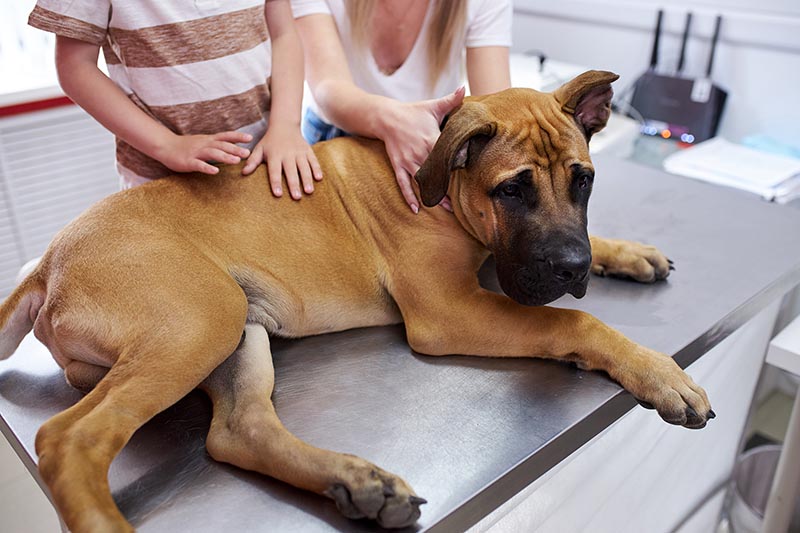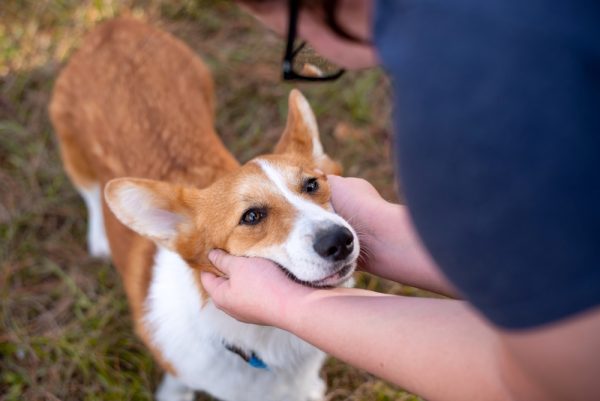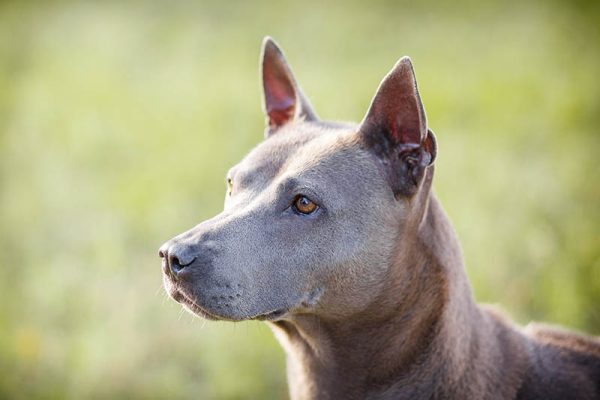Most dog owners will agree that there are few sights more peaceful than a sleeping dog. So, it’s natural to feel unnerved when your peaceful pup begins to breathe rapidly while sleeping. Fortunately, rapid breathing during sleep is not always a sign that something is wrong, and in many cases, it is simply due to your dog dreaming. However, there are certain illnesses that can cause a dog to breathe faster than normal while sleeping.
Let’s explore the most common causes for an elevated sleeping respiratory rate in canines and how to differentiate between what’s normal and what’s not when it comes to your dog’s breathing.

What Is the Normal Sleeping Respiratory Rate in a Dog?

In order to spot an abnormal sleeping respiratory rate, you need to first know what is normal. According to the Clinician’s Brief, a normal, healthy dog will take between 6 and 25 breaths per minute while sleeping. Dogs should not use effort to breathe, and their breathing pattern should be regular. Anything over 30 breaths per minute while sleeping is considered fast. Labored breathing and noisy breathing are also considered to be abnormal.
How Do I Count My Dog’s Sleeping Respiratory Rate?
The sleeping respiratory rate should be measured once your dog has been asleep for at least 15 minutes and should not be measured if the dog is paddling or twitching. Watch your dog’s chest as it moves in and out. One breath is counted when the chest moves in and out once. Use a watch or timer to count the number of breaths your dog takes in 30 seconds, and multiply this number by two. This will give you the sleeping respiratory rate.
Reasons That Your Dog Breathes Fast While Sleeping
Now that you know what’s normal for a dog, let’s explore some of the causes of an elevated sleeping respiratory rate.
Dreaming

If your dog’s breathing becomes faster than normal while sleeping, it may be that they are dreaming. Dogs have similar sleep cycles to humans and experience both non-REM and REM sleep.
REM stands for “rapid eye movement,” where the eyes move around rapidly in random directions and do not transmit visual information to the brain. This does not happen in non-REM sleep.
The sleep cycle begins with non-REM sleep, which is made up of three phases, followed by a shorter period of REM sleep. Dogs enter REM sleep after around 20 minutes of sleep. It lasts about 2–3 minutes. The most vivid dreams typically occur during REM sleep since the brain is more active in this stage than in non-REM sleep.
During REM sleep, a dog’s heart rate increases, their eyes dart around behind their lids, and the muscles sometimes twitch. You may also notice your dog’s breathing becoming quicker and more irregular. Dogs may even vocalize during REM sleep. This is completely normal and is nothing to worry about, and there is no need to wake your dog. The breathing should slow down and become deeper and more regular after a couple of minutes as the dog once again moves into non-REM sleep.
Congestive Heart Failure
An elevated sleeping respiratory rate may be a sign of congestive heart failure. This term describes the inability of the heart to adequately pump blood through the body, causing fluid to back up into the lungs or abdomen. A dog with congestive heart failure will have a consistently increased respiratory rate while sleeping.
For dogs known to have heart disease, the sleeping respiratory rate is a useful tool for owners to help monitor their dog’s condition at home. An increase in a dog’s sleeping respiratory rate can be an early sign of worsening heart disease, which would warrant a trip to the vet. By monitoring the sleeping respiratory rate, an owner can help limit how sick their dog becomes and make sure that their pet receives medical intervention sooner rather than later.
If you are unsure if a vet visit is necessary, you can talk to a vet online for guidance on the next steps.
Often, the earliest sign of heart disease is a murmur, which may be detected during a routine veterinary checkup. If your veterinarian detects a heart murmur, they may advise further diagnostic testing like chest X-rays, an echocardiogram, an electrocardiogram, and blood tests to investigate further. Depending on the findings, heart medication may be required.
Other signs of congestive heart failure in dogs include coughing that gets worse at night, weakness, labored breathing, weight loss, a swollen abdomen, and fainting episodes.

Respiratory Disease
Diseases of the lungs and the membranes surrounding the lungs (also known as the pleura) affect the ability of the lungs to function properly and can cause a dog to develop an increased sleeping respiratory rate as a way of compensating. Chronic bronchitis, pneumonia, tumors, and fluid or air in the space between the lungs and pleura (also known as the pleural space) can cause a dog to breathe rapidly while sleeping or resting. Dogs with respiratory disease will continue to have breathing difficulties while awake.
Other signs of respiratory disease in dogs include coughing, noisy breathing, low energy levels, a reduced or absent appetite, and fever.
Metabolic Acidosis
The body usually maintains a constant pH. Some illnesses affect the body’s ability to maintain a balance of acids and bases, which results in the blood becoming more acidic. This is known as metabolic acidosis. A dog with metabolic acidosis will breathe faster than normal in order to exhale carbon dioxide to raise the pH of the blood back to a normal level. The most common diseases that cause metabolic acidosis include kidney disease, diabetic ketoacidosis, and poisonings like ethylene glycol and aspirin toxicity.
In addition to a rapid respiratory rate, common signs of metabolic acidosis include nausea, vomiting, and depression.

Anemia
The cells in the body need oxygen to function normally and stay alive. Oxygen is carried from the lungs to the tissues in the body by red blood cells. A decrease in the number of circulating red blood cells in the body (also known as anemia) means that there is less oxygen available to the cells. When this happens, a dog may breathe faster to try to compensate. This may be more noticeable while sleeping or resting. Other common signs of anemia are pale gums, low energy levels, tiring quickly during play, and a fast heart rate.
There are numerous conditions that can cause a dog to develop anemia. The most common causes of anemia in dogs include:
- Tick-borne diseases
- Heavy infestations of blood-sucking parasites, such as ticks, fleas, and worms
- Toxins like garlic and onions
- Bleeding tumors
- Immune-mediated disease, which causes the destruction of red blood cells
Be sure to keep your dog’s tick and flea treatment and deworming up to date to keep them safe and stay up to date on which human foods to avoid feeding your dog.
Cushing’s Disease
Cushing’s disease, which is also known as hyperadrenocorticism, is a condition where the adrenal glands produce too much cortisol. It is usually seen in middle-aged to older dogs. An increased respiratory rate is a common clinical sign of Cushing’s disease. Affected dogs may breathe rapidly while asleep despite being in a cool and comfortable environment. This can lead to restless sleep. Cushing’s disease causes an increased respiratory rate as a result of fatty deposits around the rib cage and in the abdomen, which puts stress on the respiratory system. Cushing’s disease also causes the respiratory muscles to weaken. The liver becomes enlarged, which prevents the diaphragm from expanding properly.
Other common signs of Cushing’s disease include increased thirst and urination, increased appetite, a pot-bellied appearance, a poor hair coat, and chronic skin infections.

Obesity
Obesity has a marked effect on the ability of the respiratory system to function optimally. Overweight dogs have fat deposited around the rib cage and in the abdomen, which makes it difficult for the lungs to inflate properly and take in enough air. In order to compensate, obese dogs breathe faster.
According to the Association for Pet Obesity Prevention, an estimated 56% of dogs in the United States are overweight or obese. In addition to respiratory problems, overweight and obese dogs tend not to live as long as dogs with normal body weights and have a higher incidence of other issues such as osteoarthritis.
Other respiratory diseases, such as collapsing trachea, laryngeal paralysis, and brachycephalic airway obstructive syndrome, are exacerbated by obesity, which leads to further breathing difficulties.

Conclusion
A dog may breathe more rapidly than normal while in REM sleep. This is normal and nothing to worry about. The respiratory rate should return to normal within a couple of minutes as the dog moves into non-REM sleep. However, a consistently increased sleeping respiratory rate is not normal and may be a sign that something more serious is going on.
If your dog has an elevated sleeping respiratory rate that is accompanied by other clinical signs, such as labored or noisy breathing, coughing, fever, poor or absent appetite, or low energy levels, it is advisable to seek veterinary attention as soon as possible.
Related Reads:
- What Is a Normal Dog Respiration Rate? Vet-Reviewed Facts
- How Do Dogs Get Respiratory Infections & Signs to Monitor (Vet-Reviewed)
Featured Image Credit: Pexels, Pixabay




















